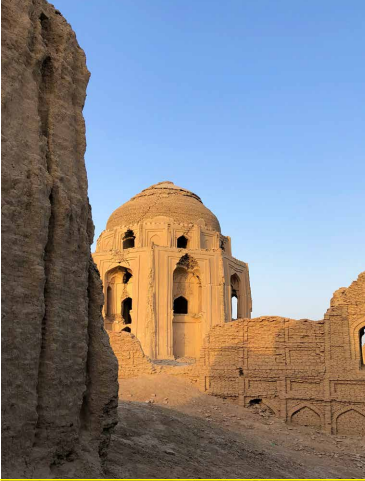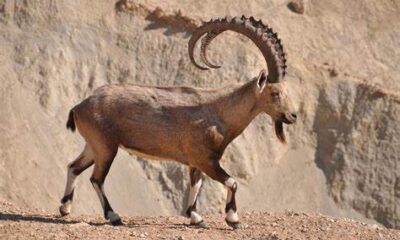Article
Judeir Damb enrichen Balochistan Archaeological
Published
1 year agoon

Judeir Damb is an archaeological site in the district Nasirabad of Balochistan, located between Jhat Pat (Dera Allah Yar) and Dera Murad Jamali. Nasirabad Division, constituting Jaffarabad and Nasirabad districts, is an agricultural area with green cultivated land all around, irrigated through the water of the Indus River. The socio-economic conditions of this region are constituted by agriculture and it is famous for its wheat and rice production. Given the proximity of the region to Sindh, it reflects a rich cultural landscape. However, little is known about Judeir Damb, an archaeological site in the region.
About
Judeir Damb is a proto-historic site and unexcavated situated in the extreme region of Kachi Plains. Even most of the locals are unaware of the historical and cultural importance of the Judier Damb. In contemporary times, the area is inhabited by native Baloch tribes living in the nearby villages. The systematic description of the site appeared in the archaeological records of Pakistan in 1964, identified and reported to the Department of Archeology and Museums of Pakistan by R.L. Raikes. Raikes describes Judeir Damb to be situated about twenty miles north of district Jacobabad Sindh, on the Kachi Plain.
During the time of its existence, Judier Damb was a moderate settlement with a thin population numbered around 20,240 and encompassed a geographical area of 2,700,000 ft. The work of Allchin also refers to the Judier Damb as an earlier and mature Indus site in the sub-continent dating back to the first half of the 3rd millennium BC. The further archaeological description of Judeir Damb site comprises the main mounds which are divided by numerous water gallies resembling the analogy of Mohenjo-Daro’s ancient streets.
Moreover, there is a small row of five mounds isolated from the main mounds on So, the origin of the civilizational culture of the Judeir Damb is linked with the Harappan people and Indus Valley civilization by various accounts.
Research Reports
GM Shar and M. Vidale have reported that objects found at the site have revealed a high degree of material civilization. The artifacts, including wares, bricks, ornaments, pottery, etc. exhibit an extraordinary uniformity level in their patterns and designs. This degree of uniformity informs about the extension of geographical and stratigraphical distribution. The objects discovered with relative abundance were of grey, greenish, and yellowish colors with a rough and thick texture, mostly plain in their composition. The wares and pottery discovered were also of Indus type. The varied shadows of colors, the rhythmic inscription of clay slip on the objects, functional edges, and horizontal lines comprised the decorative pattern of the objects found in the Judeir Dumb site.
A chronological correlation proposed by Jean Francois Jarrige suggests that Judeir Dumb represents the subsequently evolutionary cultural stage of the earlier Indus region. The Judeir Dumb reflected similar cultural patterns resembling Mohenjo-Daro, Harappa Period II, Mehrgarh VIIC, Damb-Sadat III, Nausharo I, Kot Diji, and Amri IIB. The archaeological work carried out and conducted in Balochistan also offers a relationship of continuity between the archaeological peasant culture in Balochistan and the culture of Harappa.
So, the origin of the civilizational culture of the Judeir Damb is linked with the Harappan people and Indus Valley civilization by various accounts. Jarrige’s work further proposes that Judier Damb reveals one of the earliest forms of farming settlement in the sub-continent. Different explanations are offered in various archaeological reports for the origin of the culture of Judier Damb. However, the questions about the origin and abandonment or destruction of the city are uncertain with a possible speculative explanation. Among the various archaeological explanations, the purposed reasons for the abandonment are more or less violent, such as earthquake shocks, resources deficiency, flooding among many others, which disrupted settlements, communications, and commercial life.
Hub of Civilisation
A large proto-urban flatland of Judier Damb that prospered in prehistory holds pivotal significance in reinventing the archaeological exploration in the sub-continent. The archaeologists view Balochistan as of massive importance in understanding the civilizations in South Asia. The civilizations in the Balochistan region were the essential route of trade and communication, which started during the Neolithic period. This claim is based upon the discovery of archaeological objects similar to the ones unearthed in nearby civilizations such as Harappa, Mohenjo-Daro, Kablibagan (India), Shar-e-Sokhta (Iran), Nisa (Turkmenistan), and Mundigaak (Afghanistan).
Judier Damb is one of the unexplored historical places to be researched and visited in Balochistan. The rarity and absence of research records attract archaeological researchers for further study. In addition to that, the historical importance of Judier Damb for being an essential part of the earlier human settlement, cultural evolution, and continuity of human civilization would be a site worth visiting.
A big thanks to Abdul Zahir for exploring this rich site. Such sites are storytellers and civilization preservers. Exploring such sites can enrich our tourism industry. Whereas it would also connect us with past civilizations.
You may like
-


Unity, Faith, and Discipline: The Cornerstones of Pakistan’s Motto as “Aik Qaum” (One Nation)
-


Aik Qaum: The Fusion of Integrity and Patriotism
-


“AIK QAUM” DECLARATION OF CONCEPTION
-


Dr. Abdul Qadeer Khan: The Real Hero of Pakistan
-


The Chiltan Ibex: A Rare Treasure of Balochistan
-


MANGO HEALTH BENEFITS NUTRITION
Article
Aik Qaum: The Fusion of Integrity and Patriotism
Published
3 weeks agoon
May 28, 2025By
EDITOR
We keep Integrity closest to our Heart and Patriotism on top of our mind.
Integrity and patriotism are not separate entities; they are intertwined in the soul of Pakistan. The people understand that to be a patriot is to uphold the principles of integrity. Honesty and love for one’s country are two sides of the same coin. Together, these values form the essence of “Aik Qaum.”
The fusion of integrity and patriotism is evident in the everyday lives of Pakistanis. It’s in the farmer toiling the fields, the teacher educating the youth, and the soldier guarding the borders. It’s in the child who dreams of a better Pakistan and the elderly who have seen the nation grow. “Aik Qaum” is the realization that integrity and patriotism are the heart and mind of Pakistan, beating in unison to guide the nation forward.
As we celebrate the spirit of “Aik Qaum,” we honor the values that make Pakistan a unique and resilient nation. Integrity and patriotism serve as our guiding stars, leading us towards a brighter and more prosperous future. In the heart of every Pakistani and at the forefront of their minds, “Aik Qaum” stands as a testament to the strength of a united nation, bound by the principles of integrity and the unyielding love for their homeland.
In Pakistan, “Aik Qaum” is not just a motto; it’s a way of life that embodies the enduring spirit of a proud and united nation.

Our Initiative
The fabric of the Pakistani nation has something unique in its knit, something signature and so sanguine that could keep on energizing its very fibers irrespective of the floods of considerably tough challenges posed against it since its inception. There is also a belief that Pakistan has been blessed with such a golden glitter that couldn’t be ignored by any sensible system of reason and knowledge among the league of free, upright and kind nations. The credit goes to the amazing people of Pakistan. It is more exciting to find that the people of Pakistan, be it the businessmen, doctors, parents, soldiers, students, teachers, judges, labourers or lawyers etc, have assumed the duty bestowed upon them by the founder of the nation, Quaid-e-Azam Muhammad Ali Jinnah decades ago. Quaid once said “If you will work in cooperation, forgetting the past, burying the hatchet, you are bound to succeed.” At another occasion, Quaid summed this message up in just three words: Unity, Faith and Discipline. AIKQAUM.COM is an initiative built upon the idea of translating this vision of the founder of Pakistan, Quaid-e-Azam Muhammad Ali Jinnah into a fruitful action.
There is no power on earth that could restrict us from finding those beautiful commonalities among the people of this beautiful nation. It contends to promote the psyche morale of the Pakistani nation by addressing the issues instead of dodging them. We have a team of thorough professionals fully equipped to create unique platforms, forums and projects which will bring people closer on all sensitive issues related to our national identity and progress. We also have a strong support network for successful execution of all our campaigns in order to induce greater cohesion and the spirit of coexistence across the length and breadth of Pakistan. Coincidentally, we are living through an age of increased morphing of warfare in a world that’s once again moving from unipolar to a multipolar turf. The social, political, economic and technological factors shaping the evolution of warfare are being constantly experimented and employed in our own region. In a time of increased friction between regional powers and a heightened threat on the eastern border, Pakistan faces multiple challenges posed at its internal, external and economic security.
All these factors, blended with our archrival’s constant image building campaigns, a heavily funded lobbying in the West, the new Indo-US strategic alliance, as well as India’s ambition to start a space race, puts our nation on caution and throws immense burden of responsibility on our shoulders. We are witnessing a rise of sub conventional warfare fought with guns and bombs, but won on keyboards and drawing boards. AIKQAUM.COM aspires to be a strong force of defense against the subversive forces that are trying to malign Pakistan and hurt our interests in the region. We are fully trained and equipped to meet the challenges on the social and digital front.
www.aikqaum.com, info@aikqaum.com
Our Philosophy
VISION:
To create a social awareness about the values which join our nation together while countering anti-Pakistan narratives with logical and practical rationale.
MISSION:
To infuse a sense urgency for cohesion among all ethnic, political and religious schools of thought.
VALUES:
We keep integrity closest to our heart and patriotism on top of our mind. Our work ethics and commitment to our people shall empower us to achieve success in all our pursuits.
Article
The Chiltan Ibex: A Rare Treasure of Balochistan
Published
2 months agoon
April 16, 2025By
EDITOR
The Chiltan ibex (Capra aegagrus chiltanensis), a subspecies of the wild goat, is one of the most unique and endangered animals native to Pakistan. Found exclusively in the rocky highlands of the Chiltan range within the Hazarganji-Chiltan National Park in Balochistan, this elusive animal represents the region’s rich biodiversity and ecological heritage.
Physical Characteristics
The Chiltan ibex is a strikingly beautiful species, with a robust, muscular build perfectly suited for navigating steep and rocky terrains. Males are particularly distinctive, boasting impressive curved horns that can grow up to 30 inches (76 cm) in length. Their coat is light brown, with a darker stripe running along their back and legs, providing excellent camouflage in their arid mountainous habitat.
Females are smaller in size with shorter, more slender horns, and their coloration is less pronounced, blending seamlessly into their surroundings. This camouflage helps protect them and their offspring from predators such as wolves and large birds of prey.
Habitat and Range
The Chiltan ibex inhabits the rugged, semi-arid regions of the Chiltan range, located within the Hazarganji-Chiltan National Park, southwest of Quetta. These high-altitude areas, ranging from 1,500 to 3,200 meters above sea level, are characterized by rocky cliffs, sparse vegetation, and extreme weather conditions.
The ibex is well-adapted to this challenging environment, where it feeds on grasses, shrubs, and the leaves of juniper trees. Its ability to climb steep slopes and jump across narrow ledges gives it a unique advantage in escaping predators and surviving in such inhospitable terrain.
Behavior and Social Structure
Chiltan ibexes are diurnal, meaning they are active during the day. They are typically found in small groups, with herds consisting of females and their young. Males are more solitary, joining herds only during the breeding season, which occurs in the late autumn and winter months.
During this time, males engage in dramatic displays of strength to compete for mating rights, including horn clashing and dominance rituals. After a gestation period of around six months, females give birth to one or two kids in spring, when food availability is higher.
Conservation Status
The Chiltan ibex is classified as endangered due to its restricted range, habitat loss, and poaching. Habitat degradation caused by overgrazing, deforestation, and human encroachment poses significant threats to its survival.
Historically, the ibex faced heavy hunting pressure for its horns, considered a symbol of prestige, and for its meat. Although hunting is now banned in the national park, illegal poaching remains a concern.
Conservation Efforts
To protect the Chiltan ibex and its fragile ecosystem, the Hazarganji-Chiltan National Park was established in 1980. Spanning over 32,500 acres, the park provides a safe haven for the ibex and other wildlife, such as wolves, foxes, and birds of prey.
Conservation efforts include:
- Anti-Poaching Measures: Increased patrolling and strict enforcement of hunting bans have helped reduce poaching incidents.
- Habitat Restoration: Programs to control overgrazing and reforest juniper woodlands are underway to restore the ibex’s natural habitat.
- Public Awareness Campaigns: Local communities are being educated about the importance of biodiversity and the role of the Chiltan ibex in maintaining ecological balance.
- Eco-Tourism Initiatives: Promoting responsible tourism generates revenue for conservation projects and raises awareness about the ibex’s plight.
Ecological Importance
The Chiltan ibex plays a vital role in its ecosystem as both a grazer and prey species. By feeding on shrubs and grasses, it helps maintain vegetation balance, preventing overgrowth and contributing to soil health. At the same time, it serves as a food source for predators, sustaining the natural food chain.
Protecting the ibex is not just about saving a single species—it’s about preserving an entire ecosystem that supports numerous forms of life, from tiny insects to apex predators.
Cultural Significance
For the people of Balochistan, the Chiltan ibex is more than just a wild animal; it is a symbol of the region’s natural beauty and resilience. Local folklore often intertwines with the ibex, celebrating its agility and strength. The species also draws international attention, making it a flagship for wildlife conservation in Pakistan.
The Future of the Chiltan Ibex
While conservation efforts have shown promise, the Chiltan ibex remains vulnerable. Protecting this rare species requires continued collaboration between government agencies, conservation organizations, and local communities.
By safeguarding the Chiltan ibex, we not only preserve a unique animal but also protect the fragile ecosystem of Balochistan, ensuring that future generations can marvel at the beauty and resilience of this incredible species.
The Chiltan ibex is a testament to nature’s ability to adapt and survive in the harshest of environments. As efforts to protect it continue, this majestic animal stands as a beacon of hope for wildlife conservation in Pakistan.

Unity, Faith, and Discipline: The Cornerstones of Pakistan’s Motto as “Aik Qaum” (One Nation)

Aik Qaum: The Fusion of Integrity and Patriotism








